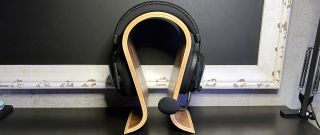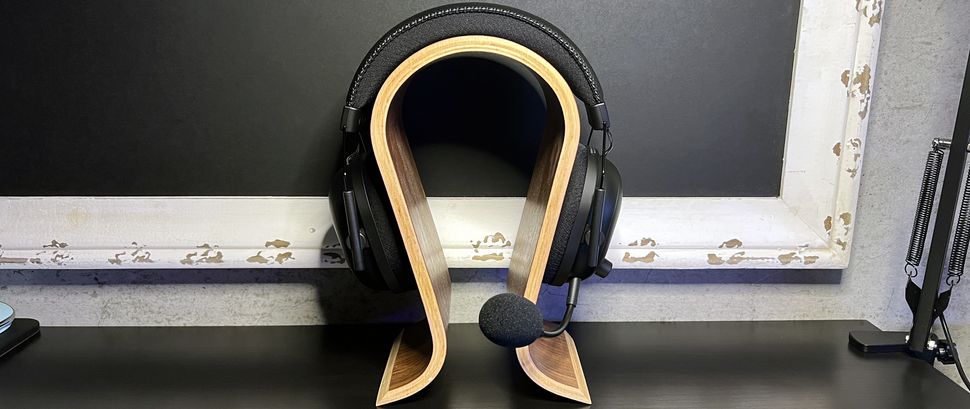Gaming headsets are just as important as other gaming peripherals: The sounds of your virtual world and how you communicate with your teammates hinge on the device you wear on your head (unless you’re listening through some of the best PC speakers). And you’ll likely be taking work calls, listening to music, and streaming your favorite shows with it, too.
Picking the perfect gaming headset isn’t as easy as it sounds. Thanks to the ever-rising popularity of esports and streaming, the enduring post-pandemic hybrid work model, and the shockingly high number of big-ticket video game titles that dropped in 2023, gamers now have more headset options than ever.
You’ve probably already got a budget in mind, but there are still several other factors to consider — connectivity, mic and audio quality, whether you need something wired or wireless. We’ve been testing gaming headsets for years, and these are the best headsets you can buy right now, for every situation.
The Best Gaming Headsets You Can Buy Today
BEST GAMING HEADSET FOR MOST

After months of testing, listening, and gaming with a rotation of headsets, my pick for best overall gaming headset is the Razer’s updated-for-2023 BlackShark V2 Pro. This wireless, over-ear headset is lightweight and extremely comfortable and it has a detachable boom mic that makes your voice sound great. It has Razer’s 50mm “Triforce Titanium” dynamic drivers and a sound profile that’s tuned for gaming (complete with several built-in game-ready presets). While this isn’t great for listening to music, it can be tweaked in Razer’s Synapse 3 software for a solid listening experience.
It does have some limitations when it comes to connectivity: it only offers 2.4GHz wireless and Bluetooth connectivity — no analog connection. The 2.4GHz/Bluetooth is also not simultaneous, but I have yet to find a multi-device gaming headset that can switch seamlessly between devices consistently. Our previous top choice, SteelSeries’ Arctis Nova Pro, might just be the gaming headset with the most versatile multi-device connectivity, and it’s fantastic when it works — but it doesn’t always work. Unfortunately, I’ve found myself wrestling with the Arctis Nova Pro’s wireless connection too often to be able to recommend it as the best gaming headset for most people, but it’s still worth a look if you want something that will connect to multiple devices at once.
If you’re looking for a headset that can mix audio from 2.4GHz wireless and Bluetooth connections, I’ve had the best luck with Logitech’s G735, while several of my colleagues like the Corsair Virtuoso RGB Wireless XT.
The BlackShark V2 Pro (2023) is an update to Razer’s BlackShark V2 Pro (originally released in June 2021). It looks almost identical to its predecessor — all black (or white/black), with a padded, leatherette-covered headband, stainless steel sliders, fabric-covered memory foam earpads, and smooth, plastic earcups. The headset is incredibly comfortable: it’s fairly lightweight (11.29 ounces / 320g), and the stainless steel sliders allow for smooth, easy earcup height adjustment. The sliders are thin and flexible enough to allow for moderate earcup swivel, and while they may look a little flimsy, they’ve been reinforced as part of the update — and are still holding up well after a year. I will point out that the earcups don’t swivel to lie flat like you’ll see in some gaming headsets; the BlackShark V2 Pro (2023) is a headset designed primarily for PC gaming and isn’t terribly convenient for travel. If you’re looking for a gaming headset that can double as a lifestyle headset, Razer’s Barracuda Pro is a lightweight, comfortable wireless gaming headset that packs away nicely in its included rigid travel case.
I have a love-hate relationship with headsets, especially when it comes to comfort: I’m particularly sensitive to tension, tugging, or excessive weight on my head (seriously — I don’t even like putting my hair up). So trust me when I say the BlackShark V2 Pro (2023) is extremely comfortable. The thin, flexible sliders make for a light (but not too light) clamping force, and the fabric-covered earpads are soft and breathable and do a very good job of passive noise cancellation (for the listener, anyway — those around me could still hear what I was listening to at higher volumes).
Audio quality isn’t the only thing you should be looking for in a gaming headset, but it’s still, arguably, the most important thing. The BlackShark V2 Pro (2023) sports Razer’s 50mm Triforce Titanium dynamic drivers, which have a frequency response range of 12 – 28,000 Hz. This is slightly wider than most gaming headsets, which typically stick to the standard 20 – 20,000 Hz. The drivers are tuned for — surprise, surprise — gaming, out of the box, and the headset comes with five game-ready EQ presets for Apex Legends, Call of Duty, CS:GO, Fortnite, and Valorant. These presets, along with the four default non-game presets, can be customized with Razer’s Synapse peripheral software — and all changes save directly to the headset. The headset also features built-in THX Spatial Audio, which isn’t overly impressive but offers a slightly wider soundstage and more layered environmental sounds in games with pre-built THX profiles.
The BlackShark V2 Pro (2023) comes with a detachable boom mic, and it is excellent. It’s a 9.9mm condenser mic with a 32 kHz sampling rate and an internal pop filter, and it’s the best-sounding headset mic we’ve tested — in one of our meetings, a coworker said I sounded better over the headset’s mic than I did in real life. (Thanks, Andrew.) The headset doesn’t have built-in mics, so removing the boom mic mutes you. There’s also a mute button on the left earcup, but there’s no visual indication that you’re muted — and I find it difficult to remember which button state means mute/unmute (in this case, you’re muted when the button is pushed in), so it’s easier to just detach the mic and know for sure.
The biggest drawback of the BlackShark V2 Pro (2023) is its connectivity — or rather, its lack thereof. Don’t get me wrong: it’s a wireless headset, and it does offer both low-latency 2.4GHz wireless (via a USB-A dongle) and Bluetooth 5.2. It doesn’t offer the simultaneous audio-mixing of the two connections like you’ll find on SteelSeries’ Arctis Nova 7 or Corsair’s Virtuoso RGB Wireless XT; the BlackShark V2 Pro (2023) lets you connect to both 2.4GHz wireless and Bluetooth 5.2 at the same time, but you’ll need to switch between the two connections manually using a multi-function button on the right earcup. The headset is also wireless-only. There’s no wired connectivity at all — the USB-C port is just for charging. This might be a dealbreaker for some — I thought it would be, for me, but I found that it was actually not a problem as long as I didn’t have a device that required a 3.5mm analog connection.
The main reason I look for wired, specifically analog, connections in gaming headsets is because wired connections just work where wired connections often do not — but the BlackShark V2 Pro (2023)’s wireless connections are rock-solid. I haven’t had any issues with getting the headset to connect to either of its wireless connections, or switch between the two, so I haven’t had the opportunity to wish for an analog connection. The headset also offers excellent battery life — up to 70 hours, which is nearly three times that of its predecessor — and can be used wirelessly while plugged in and charging, so you shouldn’t run into a situation where you need to pause in the middle of playing. Plugging the headset in may not be quite as convenient as swapping out the battery in the SteelSeries Arctis Nova Pro, because it does mean you’ll be tethered to a USB port for a little while, but it’s not too bad.
The BlackShark V2 Pro (2023) isn’t the most versatile gaming headset you can buy, but it’s excellent for gaming — especially PC gaming. It’s lightweight and incredibly comfortable, with a game-tuned audio profile and a mic that’s practically standalone quality, and while it’s wireless-only, it at least does wireless very, very well. As long as you’re not dead-set on having a wired connection, this is the best headset for most PC gamers.
BEST BUDGET GAMING HEADSET

You don’t need to spend a lot for a great gaming headset. HyperX’s Cloud III isn’t the most feature-rich headset on the market, but it does the basics — balanced, detailed audio, a lightweight, comfortable frame, and a detachable boom mic — very well. And it’s priced at a relatively budget-friendly $100.
Unlike the BlackShark V2 Pro (2023), the Cloud III is a wired-only headset — it can connect to your PC via USB-C, and it also offers an 3.5mm analog connection for, well, anything else. HyperX does have a wireless version of the Cloud III — the Cloud III Wireless, which is very similar to the Cloud III but only offers 2.4GHz wireless connectivity and costs an extra $70.
The Cloud III is one of the most comfortable headsets I’ve tested. Actually, I’ll just go ahead and say it: it’s the most comfortable headset I’ve tested (the BlackShark V2 Pro (2023) is a close second, however). It weighs 10.86 ounces (308g) and has a leatherette-covered padded headband, aluminum forks that curve toward the earcups, and leatherette-covered memory foam earpads. It also somehow has the perfect clamping force — light enough that you’ll forget you’re wearing a headset, but not so light that it falls off your head whenever you look up (or down).
This is the eight-years-in-the-making successor to HyperX’s popular Cloud II headset, and it’s an excellent update — but, in some ways, mostly just an update. It sports the same 53mm dynamic drivers as the Cloud II, though they’ve been redesigned and angled to deliver “accurate, smooth, and detailed sound by directing audio into the ears at a more optimal position.” The drivers have a frequency response range of 10 – 21,000 Hz, and offer a balanced audio profile with impressive bass and solid gaming performance. The headset has DTS surround sound when connected via USB-C to your PC, but it’s very subtle (maybe too subtle) — however, directional sound is good and there’s plenty of environmental detail in games like God of War: Ragnarok and Uncharted 4.
The Cloud III has a detachable boom mic with a built-in mesh pop filter that sounds… fine. That might sound like a bad thing, but it’s not — most gaming headsets don’t have the impressive mic quality of the BlackShark V2 Pro (2023), which is why it’s always a good idea to pair your headset with one of the best gaming microphones. The Cloud III’s boom mic is about what I expect from a headset mic — it made my voice sound better than if I was trying to talk through my webcam mic or a built-in laptop mic and it did a good job of removing background noise, but it wasn’t anywhere near broadcast quality.
If you’re looking for a headset that does the basics, well, and won’t break the bank, the HyperX Cloud III is a great choice. It’s the most comfortable headset I’ve ever tested, and it offers great audio, a decent mic, and a solid, wired connection (and it actually has two forms of wired connectivity, which is more than most wired headsets). If you’re looking for something even cheaper than $100, the $60 SteelSeries Arctis Nova 1 is a wired (analog-only) headset that’s also very lightweight and comfortable, with great audio and a retractable boom mic.
BEST GAMING HEADSET FOR AUDIOPHILES

Here’s the thing about PC gaming headsets: audio quality matters, but so do a lot of other things. That doesn’t mean audio quality isn’t the most important facet — it is — just that there are so many other factors to consider when picking a gaming headset that it often ends up being (somewhat) sidelined. But if you’re a gamer who’s looking for top-notch audio quality above all else, the Audeze Maxwell is the best gaming headset for you.
The Maxwell is a large, wireless over-ear headset with a steel and aluminum frame and a detachable boom mic. It features Audeze’s newly-designed 90mm planar magnetic drivers — which are different from dynamic drivers and have a frequency response range of 10 – 50,000 Hz (much wider than that of a typical gaming headset, which is usually between 20 – 20,000 Hz). There aren’t many gaming headsets with planar magnetic drivers, but there are a few, including Audeze’s LCD-GX and HyperX’s Cloud Orbit S. The Maxwell’s default sound profile is tuned for gaming — so it’s a little unbalanced, with stronger lows and brighter highs than you’re probably looking for in a listening headset. You can, however, use Audeze’s software (Audeze HQ) to adjust the EQ and get a fantastic-sounding, balanced audio profile that’s clean, crisp, and full of detail. I might be a little biased as I’ve always been a big fan of planar magnetic drivers, but it’s hard to beat the accuracy and detail they deliver, especially at this price point ($300 – $329, depending on which version you buy).
Unlike the LCD-GX, which is less of a gaming headset and more of an audiophile headset slightly rebranded to appeal to gamers, the Maxwell is definitely a gaming headset. It comes with both a detachable boom mic and built-in beamforming mics and offers four forms of connectivity — low-latency 2.4GHz wireless, Bluetooth 5.3, wired via USB-C, and wired via 3.5mm analog. It comes in two variations, a $300 PlayStation variant and a $329 Xbox variant (which is more expensive because it includes Microsoft’s license as well as an embedded Dolby Atmos license). It’s also one of the best wireless headsets we’ve tested in terms of battery life: 80+ hours over 2.4GHz wireless (the best wireless headset we’ve tested for battery life, however, is still the 300-hour HyperX Cloud Alpha Wireless — by far).
The Maxwell does an… okay job of executing its gamer-friendly features. The detachable boom mic is pretty good, with full-sounding audio and AI noise suppression, but the built-in mics are basically just a courtesy. It’s always nice to see a headset with several forms of connectivity, but I wasn’t the biggest fan of how Audeze chose to implement the 2.4GHz wireless/Bluetooth interaction — it’s not simultaneous audio-mixing, which I can live without, but it also doesn’t support manual switching. Instead, it switches between connected devices automatically, prioritizing Bluetooth. While I understand the reasoning behind this — it’s so you won’t miss important notifications and phone calls on your Bluetooth-connected device — I would much prefer the option to choose, manually. This was so frustrating for me that I ended up just having to disconnect my phone from the Maxwell completely, because my immersive, fantastic-sounding gaming audio kept getting interrupted by robot-spam calls.
The Maxwell is also a large headset. That’s not to say it’s uncomfortable, but you’re definitely not going to forget you’re wearing it. It weighs 1.06 pounds (490g), and has large, round, glass-infused nylon earcups to house its 90mm drivers. It has leatherette-covered foam earpads that are contoured to fit the curvature of your skull — that’s how large these earcups are. It’s not super adjustable, either — there’s a leatherette tension headband that can be shortened or lengthened via three sets of notches on either side, and the earcups swivel and tilt. The earcups also swivel to lie flat for travel/storage, but the headset doesn’t come with a case and is pretty bulky for traveling. That didn’t stop me from traveling with it, however — I wore it on a 12-hour flight and didn’t once feel discomfort from the heft, clamping force, or overall size, but I also never forgot I was wearing a headset.
The Maxwell is the best-sounding gaming headset you can buy. It’s definitely more of a gaming headset than Audeze’s LCD-GX (and it’s priced more like one, too), and while it’s not perfect at implementing its gaming features — it’s not bad.
QUICK GAMING HEADSET SHOPPING TIPS
- Wired or wireless: Wired headsets are less expensive, easy to connect, and don’t need to be charged. If you typically game at your desk, a wired option will keep things cheap and simple — it’s difficult to misplace and it won’t die on you mid-game. But there’s no denying the convenience of a wireless headset, which lets you move around without being tethered to your PC, and can connect to other devices — sometimes simultaneously — such as phones, tablets, and consoles.
- 2.4GHz vs. Bluetooth: If you do go with wireless, only a low-latency 2.4GHz wireless connection will be fast enough for competitive gaming. Bluetooth is still convenient for when you’re not gaming, however, and is a good additional feature to look for if you want a headset that can double as a pair of lifestyle headphones.
- Headband and earcups: Comfort is more subjective and difficult to measure than audio output/input, but it’s probably the most important factor to consider when you choose your headset. Check measurements to make sure the headband expands enough to fit your head, and look for earcups that tilt and pivot to accommodate your skull. Earcup material can make a big difference when it comes to both comfort and acoustic performance — leather/leatherette offers better passive noise isolation, while fabric is more breathable.
- Audio: In addition to detailed, accurate reproduction and good spatial resolution, the best gaming headsets can also connect to, and mix, multiple audio inputs. If you’re looking for immersive sound, look for a headset with a wide, detailed soundstage and decent virtual surround-sound.
- Microphone: An external boom mic isn’t strictly necessary, but will help pick up your voice (and only your voice) clearly. Of course, if you’re planning on using this headset away from your PC, you’ll want to make sure the boom mic tucks away or detaches from the headset.




